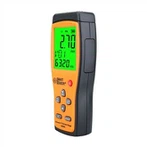Common troubleshooting and maintenance tips for digital multimeters are as follows
For a faulty instrument, you should first check and determine whether the fault phenomenon is common (all functions cannot be measured) or individual (individual functions or individual ranges), and then distinguish the situation and solve it accordingly.
1. If all gears fail to work, focus on checking the power circuit and A/D converter circuit. When checking the power supply part, you can remove the laminated battery, press the power switch, connect the positive test lead to the negative power supply of the meter under test, and connect the negative test lead to the positive power supply (for a digital multimeter). Turn the switch to the diode measurement position. If it displays is the forward voltage of the diode, it means that the power supply part is good. If the deviation is large, it means there is a problem with the power supply part. If there is an open circuit, focus on checking the power switch and battery leads. If a short circuit occurs, you need to use the circuit breaking method to gradually disconnect the components using power, focusing on checking the operational amplifier, timer, A/D converter, etc. If a short circuit occurs, generally more than one integrated component will be damaged. The A/D converter can be checked at the same time as the basic meter, which is equivalent to the DC meter of an analog multimeter. The specific inspection method is:
(1) The measuring range of the meter under test is turned to the lowest DC voltage range;
(2) Measure whether the working voltage of the A/D converter is normal. According to the A/D converter model used in the table, corresponding to the V+ pin and COM pin, whether the measured value is consistent with its typical value.
(3) Measure the reference voltage of the A/D converter. The reference voltage of commonly used digital multimeters is generally 100mV or 1V, that is, measure the DC voltage between VREF+ and COM. If it deviates from 100mV or 1V, use an external potentiometer. Make adjustments.
(4) Check the display number whose input is zero, short-circuit the positive terminal IN+ and the negative terminal IN- of the A/D converter, so that the input voltage Vin=0, the meter displays "00.0" or "00.00".
(5) Check the monitor for full bright strokes. Short-circuit the test terminal TEST pin and the positive power terminal V+ to make the logic ground become a high potential and all digital circuits stop working. Since DC voltage is applied to each stroke, all strokes light up and the alignment meter displays "1888", and the alignment meter displays "18888". If there are missing strokes, check whether there is poor contact or disconnection between the corresponding output pin of the A/D converter, the conductive adhesive (or connection), and the display.
2. If there is a problem with some files, it means that the A/D converter and power supply part are working normally. Because the DC voltage and resistance files share a set of voltage dividing resistors; the AC and DC currents share a shunt; the AC voltage and AC current share a set of AC/DC converters; others such as Cx, HFE, F, etc. are composed of independent converters. . Understand the relationship between them, and then according to the power diagram, it is easy to find the fault location. If the measurement of small signals is inaccurate or the displayed numbers fluctuate greatly, focus on checking whether the contact of the range switch is good.
3. If the measurement data is unstable, and the value always increases cumulatively, short-circuiting the input terminal of the A/D converter, and the displayed data is not zero, it is generally caused by poor performance of the 0.1μF reference capacitor.
Based on the above analysis, the basic order of repairing a digital multimeter should be: digital meter head → DC voltage → DC current → AC voltage → AC current → Resistance range (including buzzer and check diode positive voltage drop) → Cx → HFE , F, H, T, etc. But don't be too mechanical. Some obvious problems can be dealt with first. But when making adjustments, you must follow the above procedures.
In short, after proper testing of a faulty multimeter, we must first analyze the possible location of the fault, and then find the fault location according to the circuit diagram for replacement and repair. Because the digital multimeter is a relatively precise instrument, the components must be replaced with components with the same parameters. Especially when replacing the A/D converter, a manifold that has been strictly screened by the manufacturer must be used, otherwise errors will occur and the required results will not be achieved. Accuracy. The newly replaced A/D converter also needs to be checked according to the method mentioned above, and it must not be trusted just because it is new.
At present, there are many domestic manufacturers of digital multimeters, and their quality varies. It is difficult to find quality problems with double-sided copper clad boards during repairs. When the insulation strength of the resin board is not enough, the main manifestation is that the error is large when measuring high voltage, and it must be distinguished from the resistance change of the voltage dividing resistor when repairing. In this case, it is best to use the circuit break method to find the fault point. The burned and carbonized parts must be cleaned to meet insulation requirements. When the signal cannot be input due to the breakage of the transition hole in the double-sided connection, it is easy to be confused with the defective transfer switch and difficult to separate. For this type of fault, the short circuit method should be used to find the fault point.






